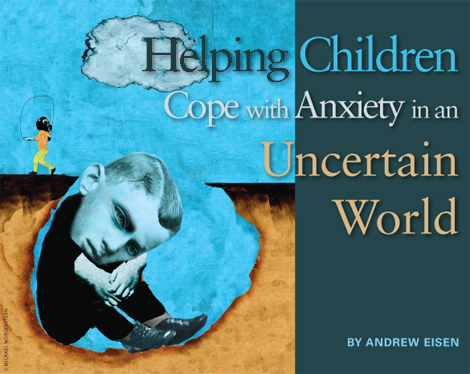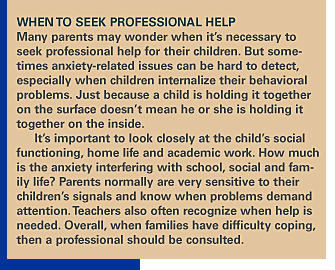

“As a child I was afraid of everything. Going to school, the dark, dogs, you name it. I always felt sick to my stomach. My mother said I was a sensitive child. My father tried to toughen me up. It didn’t work … Nothing did. No one knew what was wrong with me. Today, I’m 41 years old, still fearful, but finally getting help. If I only knew then what I know now.” — STAN H.
An estimated 40 million Americans, like Stan, suffer from anxiety disorders. The health care costs alone for adults struggling with anxiety exceed $42 billion a year. More importantly, the emotional impact of these disorders can be devastating. Checkered work histories, troubled relationships and dreams unfulfilled are all too common. And by studying the retrospective histories of adults like Stan, we are learning that anxiety often begins early in life. Research indicates that approximately 20 percent of school-aged children and adolescents could be diagnosed with anxiety disorders such as generalized anxiety disorder, separation anxiety disorder or social anxiety disorder. Unfortunately, a child’s anxiety is often viewed as “just a phase.” But, researchers are dispelling the myth that anxiety — separation anxiety in particular — is simply a childhood phenomenon. If left untreated, childhood anxiety often exerts its influence across the lifespan.
The Phenomenon of Separation Anxiety
A child may not suffer from a full-fledged disorder, yet anxiety and fearfulness still can interfere with physical and emotional well-being. In our work at Fairleigh Dickinson University’s Child Anxiety Disorders Clinic (CADC), we have found that as many as 50 percent of children and adolescents in a general school population report at least one symptom of separation anxiety. This may sound inconsequential, but a parent whose child refuses to go to school quickly learns how disruptive this can be for the whole family.
Separation anxiety, however, is not just about children who are afraid to go to or stay at school. Our research at CADC has identified four distinct types of separation anxiety, each with their own unique concerns. The first two types are the Follower and the Visitor. The Follower is afraid to be alone in one part of the house during the day (even if the parent is present elsewhere in the house), while the Visitor is afraid to sleep alone at night.
The Follower has a significant fear of getting sick (vomiting) that is so great that the child needs to “shadow” the parent, just in case illness occurs. In some cases, the parent cannot even go to the bathroom alone.
The Visitor is terrified of an intruder break-in — so much so, that someone must remain alert throughout the night. The Visitor may stay up very late, visit the parent’s bedroom repeatedly or, end up sleeping in the parental bed. And while fear of sleeping alone at night is our most common referral, Visitors are not limited to young children. We see many young adolescents as well who are still sleeping in the parental bed, not by family choice.
Unlike the Follower and the Visitor who are afraid to be alone, the Misfortune Teller and the Timekeeper are both afraid of being abandoned. The Misfortune Teller doesn’t like to venture far from home because of the possibility of a personal catastrophe, such as a panic attack or a serious illness. As a result, the Misfortune Teller is fearful of participating in social and extracurricular activities unless a “safe person” who can prevent the catastrophe from occurring remains nearby.
The Timekeeper is afraid of being dropped off places because of dreadful worries that something terrible will occur to the parent, such as being killed in a car accident. For this reason, the Timekeeper may refuse to separate from the parent to go anywhere, unless granted constant access (e.g., cell phone) to the parent’s whereabouts. The Timekeeper keeps track of a parent’s every waking moment.
Why Are Children So Worried?
“Why is my child so fearful or worried?” parents ask. After all, “nothing bad has ever happened before.” It’s important to keep in mind that nothing bad has to happen. Anxiety by nature is irrational. Most children referred to the CADC have never been the victim of an intruder break-in and may have only become physically ill once or twice in their entire lives. Yet they “feel” impending doom lurking around every corner.

In the mind of an anxious child, normal occurring events like a minor car accident, stomach virus or getting picked up a few minutes late become over-generalized. Of course, scary and violent events depicted by television broadcasts, movies, newspapers and books don’t help. We’re living in an uncertain world. Threats of terrorism and war, school killings, natural and man-made disasters and environmental dangers are creeping up on us.
But the question remains: Why does one child become vigilant about robbers after hearing a story about a burglar in another neighborhood, while another child doesn’t give it another thought? Anxiety begins with a biological vulnerability. Every individual comes into this world with a certain proneness to worry, panic, obsessive-compulsive behavior and depression, among other things. It’s this vulnerability that makes us more or less sensitive to the impact of life experiences.
Power of Cognitive Therapy | When It's More Than Anxiety | About the Author

FDU Magazine Home | Table of Contents | FDU Home | MyFDU.net | Blog About It
©Copyright 2009 Fairleigh Dickinson University. All rights reserved.
For a print copy of FDU Magazine, featuring this and other stories, contact Rebecca Maxon, editor,
201-692-7024 or maxon@fdu.edu.